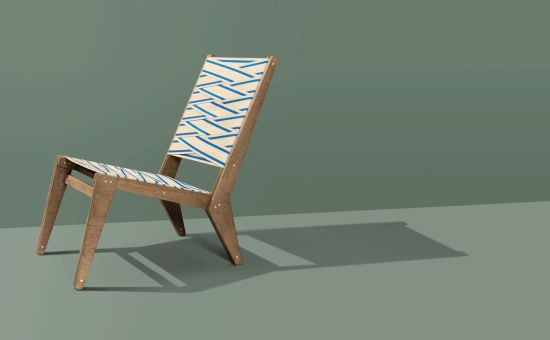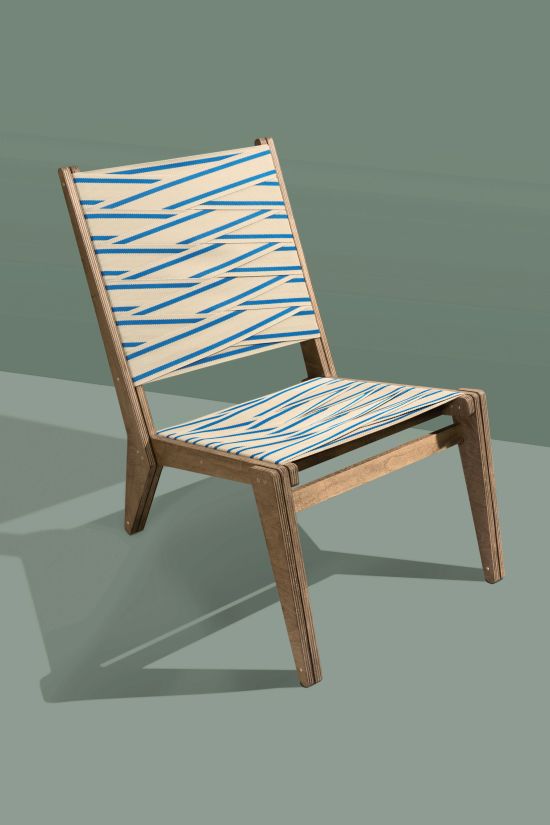
Your Shot: HORNBACH’s Affordable Lounge Chair that You Have to Build Yourself

WERKSTÜCK Edition 001 was borne of an intriguing collaboration between German DIY chain HORNBACH, its agency Heimat and revered designer and architect Sigurd Larsen. The project’s premise is that great design should be democratic and accessible to all - not just those who can afford it. There is a catch, though. The WERKSTÜCK cannot simply be bought – anyone who wants one of these desirable chairs has to get to work and build it with their bare hands.
At the core of this campaign is the ‘Builder’s Book’, which contains carefully illustrated step-by-step instructions about how to build the chair, as well as a list of materials needed (all of which can be bought at HORNBACH). But the book is also so much more than that - it has design to match that of the chair and takes the time to tell the story behind the involved materials.
And so, at around €130 for the required materials and €18 for the Builder’s Book, the WERKSTÜCK lounge chair is an investment of time and passion rather than money.
LBB’s Addison Capper chatted with designer Sigurd and Heimat’s management supervisor for HORNBACH, Tim Holtkoetter, to find out more.
LBB> What was the initial brief like from HORNBACH for this campaign?
TIM> For this project there really was no initial brief. We consistently engage with the HORNBACH brand creatively here at Heimat, and the idea simply developed within this process. At some point we presented it to the client and instantly everybody at HORNBACH was hooked.
LBB> HORNBACH is a DIY chain - high-end design isn’t something immediately associated with the brand. So, where did the idea for this kind of project initially come from and why is it a good fit for Hornbach?
TIM> The WERKSTÜCK Edition is very closely connected to the core of the HORNBACH brand. Since year one, HORNBACH has stood for ‘passion for DIY projects’ and creating something great with bare hands. The possibilities are endless, and that is what we wanted to show with the project. Through that, we wanted to inspire people to get creative themselves.
When the idea came up, we instantly found the process of redefining the gap between avantgarde design and the mass market with this project very fascinating. World class design that you can build yourself, with materials purchasable at a home improvement store, opens up a whole new perspective: high-end design and DIY are not a contradiction. Quite the contrary is true!
LBB> This kind of interdisciplinary collaboration is quite prevalent at the moment - if you look to the fashion world, you have brands like Nike collaborating with quite high-end fashion brands. Did this feed into your inspiration at all? If so, how?
TIM> We really embrace collaborations - but only if they are authentic and believable. Many of the brand collaborations we notice today rather evoke the question: what actually connects the two brands cooperating? For the WERKSTÜCK Edition that is fundamentally clear: with his Danish design roots, Sigurd Larsen, as an architect and designer, impersonates the philosophy that ‘design is for everyone’, which is also the DNA of the WERKSTÜCK Edition. Therefore this project is much more than just a marketing collaboration. It is about creating something new together and about telling that story.
LBB> While we’re on the subject, why was Sigurd the perfect fit?
TIM> When we were looking for potential designers for the WERSTÜCK Edition 001, we paid special attention to the philosophy they stood behind and how this philosophy fits with the HORNBACH brand essence. Sigurd was simply the perfect match. He is an exceptional Danish designer and architect creating great and functional things with simple materials, continuing the long tradition of what Danish design stands for. Also, the chemistry was just right from the beginning, which is an extremely important foundation for such an undertaking.
LBB> And Sigurd, why was it something you were keen to get involved in?
SIGURD> When I was first approached I think it was at a time when the idea was still in the making, they were working out what it could be and how the collaboration could work. We met up a few times to discuss that, so I wasn’t presented with a finished package, which was quite nice actually. One of my concerns was what it meant for a designer/architect like myself to work with the equipment of a warehouse and the external communications around that - because it is quite an unusual collaboration. But we agreed quite early on that the product of this whole thing would be a book, not a piece of furniture that we would try to convince people to buy. It had to be centred that collaborative approach where people would build it themselves. I found that framework very interesting and exciting.

LBB> And so how was it for you to work with a warehouse in this way?
SIGURD> Well, I’m not a complete alien in that setting - we get all of our supplies from there! But to design something made specifically from of those materials is quite exciting because, if you think of a warehouse as a big box of materials, we had to look at all of those materials and think about them in a different context. We went to HORNBACH at first to look at the materials and evaluate their aesthetic and potential uses.
LBB> So you did that at first - what were the next steps?
SIGURD> We played a little game actually. Our whole design team went to a HORNBACH. We each had a walk around on our own, and then took each other on a tour to show off what each of us had found. Then we took some of the materials back to the office and began brainstorming together. We had around 15 sketch ideas which, over the course of a few weeks, we cut down to three proposals.
They were all different pieces of furniture - we hadn’t said by this point that it should be a lounge chair. But we figured that it would be a good ’001’ for WERKSTÜCK Edition because it has this lovely sculptural value - if people build it, they will be proud of it. It doesn’t belong in the closet, it belongs in the middle of the room, as a statement piece. It’s also something that can be used as a one-off - if we had made a dining chair for example, people would feel more obliged to have to make six of them or something. We had a number of reasons for opting for a lounge chair that were very practical and others that were more emotional.
LBB> At the heart of this campaign is the celebration of great, old-fashioned craft and practical skills - things that I think are being lost now! I’m 26 and if you asked me to hang a shelf I’d struggle. Did this play a role in the development of WERKSTÜCK?
TIM> I absolutely agree – the confidence in one’s own manual skills is being lost, especially among the younger generation. We often prefer to buy something that’s already been built for us. It’s faster and sometimes even cheaper. Having that in mind, the WERKSTÜCK Edition is somehow also an invitation to be brave and have confidence in yourself. The reward is priceless because the connection you have with something you’ve created yourself, with your own hands, is way more precious and emotional than to something you simply bought.
LBB> A major part of the WERKSTÜCK project is the gorgeous book - and it features a lot more than just instructions on how to build the chair. Can you tell us a bit more about what’s inside and why?
TIM> The book takes its time to tell the big idea behind the project. For us, it was a matter of heart to let readers dive into the story and find out how this all evolved. The WERKSTÜCK Edition is just so much more than an advertising campaign. Also, we thought that it was time to worship and recognise the beauty of all materials that you can buy at a hardware store by portraying their aesthetics. An ordinary screw suddenly shines in a new light.
LBB> How easy is it for the average, at-home DIYer to put the chair together?
SIGURD> We agreed at the beginning that we’d challenge the participants more than, say, what it takes to put some Ikea furniture together. The typical HORNBACH customer is someone that enjoys working with tools, so to build this chair you have to use a jigsaw for example - it’s not just a case of using some screws to put things together. But we provide them with a stencil so you have something to guide the cuts, plus there’s a help video online, so I think we can pick up people who haven’t necessarily worked so much with their hands before. I think the design does help people too - for example, if their precision with laying the bands isn’t quite there, there’s actually a layer of wood hiding all the bad details.
LBB> What are those bands?
SIGURD> They were originally intended to be underneath an armchair, hidden as a stabiliser.

LBB> That’s kinda funny, as they’re still, in a way, being used for the same purpose - but being shown off, front and centre.
SIGURD> Yeah, exactly. They had the required strength. But we liked the aesthetic of it too - we were lucky that is was a nice blue colour!
LBB> This is actually WERKSTÜCK 001 - does that mean that you have more of this type of thing in the works? What kind of furniture would you like to explore in the future?
TIM> Absolutely! The next WERKSTÜCK pieces are in the pipeline and we can’t wait to soon WERKSTÜCK 002. We can say this much for now: it won´t be a lounge chair next time!
LBB> This is a very non-traditional campaign - what were the trickiest aspects of the project and how did you overcome them?
TIM> The special challenge was that we created a new (physical) product that you can buy at HORNBACH all over Europe… and we also created a completely new brand. Certainly that takes more effort than producing an advertising campaign. A lot more people and departments are involved, especially within HORNBACH, than just the marketing department. On top of that, none of the involved parties had done something like this before. What a special excitement with frontier spirit that was!
LBB> And Sigurd, to round things off, I’m intrigued to know how you found working with an ad agency and a brand in this way?
SIGURD> It was interesting because usually my full focus is on the design of the object, the end result. But with this, the story behind making that object was just as important. That notion of storytelling is so fascinating because it’s so important in transmitting and explaining what we do - and I’m so interested in the ways we speak to our clients and connect with people who aren’t necessarily as nerdy about what we do as we are. That really is the specialist field of an advertising agency, so working with them was really interesting.













